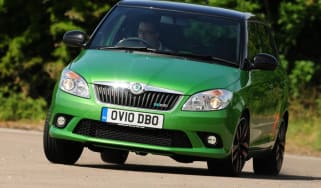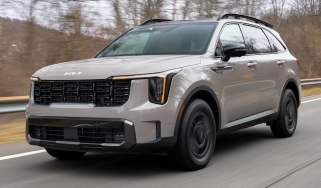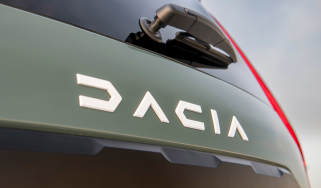Skoda Fabia hatchback (2007-2014) review
“The Skoda Fabia is a cheap and basic supermini that offers decent comfort and good practicality.”
Pros
- Cheap to buy
- Very practical
- Comfortable to drive
Cons
- Poor handling
- Cheap feeling interior
- Poor equipment levels on base spec
The Skoda Fabia is a supermini, so it’s a rival for cars such as the Ford Fiesta and Vauxhall Corsa. It’s based on the Volkswagen Polo and shares a lot of components with that car. So with the Fabia, Skoda is basically offering you a cut-price Volkswagen Polo (albeit with a lower quality interior and without the premium badge on the bonnet).
It’s practical, comfortable and it features some class-leading diesel engines that offer excellent economy and efficiency while still having plenty of power. There is a choice of six specification levels: entry-level S, SE, Elegance, GreenLine II, Monte Carlo and top-of-the-range vRS.
The Fabia won’t set your world on fire – it’s a car you buy with your head rather than your heart – but it is extremely capable.
Not sure what you're looking for? Find out what we think is the best small car by watching our video below.
MPG, running costs & CO2
Skoda is part of the Volkswagen Group, which is an expert in developing ultra-efficient technologies, so it’s no surprise that the Fabia boasts very low running costs.
There is a range of efficient petrol and diesel engines to choose from – but even the performance-focused vRS model, which features a turbocharged 1.4-litre petrol engine, will do 45mpg. The most efficient model in the range in the GreenLine II version fitted with a 1.2-litre diesel engine. It will do 83mpg and 89g/km CO2, making it one of the cleanest cars with an internal combustion engine available today. Not only is it exempt from road tax, it has an even higher mpg figure than the super-efficient Polo BlueMotion from sister company Volkswagen.
More reviews
In-depth reviews
- Skoda Fabia review - a great-value, practical supermini
- Skoda Fabia vRS review (2010-2014)
- Skoda Fabia hatchback - Interior & comfort
- Skoda Fabia hatchback - Practicality & boot space
- Skoda Fabia hatchback - Reliability & safety
- Skoda Fabia hatchback - MPG, running costs & CO2
- Skoda Fabia hatchback - Engines, drive & performance
- Skoda Fabia hatchback review (2015-2021)
We’d recommend the 1.6-litre diesel engine, though, because it’s quite a bit cheaper than the GreenLine II model and will still do 67.3mpg and 109g/km CO2 – putting it in tax band B, which is free for the first year and £20 per year after that. Skoda also offer an all-inclusive servicing package and extended warranties to help keep costs down.
Engines, drive & performance
Driving the Fabia around town, it feels narrower than many of its main competitors, which makes it less stressful, more fun and easy to park in tight spaces.
This is further helped by good visibility and light steering, while space in the in front is generous. Once you take the Fabia off the beaten track, the similarities with the Volkswagen Polo on which it’s based become noticeable, both being engineered more with comfort in mind than sporty performance. The soft suspension absorbs most bumps and potholes without much difficulty, making it suited to long-distance journeys.
Entry-level petrol engines are somewhat underpowered, but go for one of the 1.2-litre TSI turbocharged engines and you’ll get a great mix of performance and economy.
Interior & comfort
The Fabia performs very well on the UK’s rough roads, thanks to a soft suspension set up that is focused more on comfort than sporty performance. It may not handle as well as a Ford Fiesta, but the Fabia does feel solid through the corners and offers accurate steering that is nice and responsive.
Generally, the Fabia is calm and comfortable, but the 1.2-litre TDI diesel fitted in the Greenline II model gets pretty noisy, growling loudly when idling.
If you regularly clock up miles on long motorway drives, we suggest you look at one of the 1.6-litre TDI diesels or turbocharged 1.2-litre TSI petrols, because road, wind and tyre noise are nicely dampened and the interior is good quality. Plus, the driving position is good, with plenty of adjustment in the seat and steering wheel. There's also plenty of room up front, and, with some effort, you can squeeze three adults across the back seat thanks to the Fabia’s high roofline and boxy shape.
Practicality & boot space
It may look small from the outside, but the Fabia is actually surprisingly roomy on the inside. Skoda’s design team have done a great job of making the most out of the available space. You can fit four adults inside in complete comfort and even squeeze a fifth into the middle back seat without hearing too many complaints.
It’s bigger inside than the Volkswagen Polo on which it is based, and also has a bigger boot. It has 315 litres of capacity with the standard-fit split-folding rear seats up and 1,180 litres if you fold them down. That compares well to rivals, the Polo only has 280 litres of capcity, the Ford Fiesta has 290 litres and the SEAT Ibiza 292 litres. There are also plenty of cubbyholes around the cabin for sorting away loose items, as well as a big glove compartment.
The Fabia is one of the most practical cars in the supermini class, but those looking for even more storage capacity should check out the Skoda Fabia estate or the Honda Jazz.
Reliability & safety
The Fabia has been set-up to be easy to drive rather than exciting. If it’s driving thrills you’re after, then take a look at the Ford Fiesta, which is the best car in the supermini class to drive. The Fabia will get you where you need to go – and do it well, but it won’t put a smile on your face in the process.
It’s good around town thanks to the fact that it feels narrower than a lot of other superminis, which makes navigating packed city streets a lot less stressful – and also makes parking easier. And because it’s so comfortable and quiet, it’s a decent motorway cruiser, too. The steering is light, which makes it easy to use but doesn’t offer enough feedback to allow for more spirited driving on twisty country roads.
Entry-level petrol engines are a bit underpowered, but the 1.2-litre turbocharged petrol engine and the 1.6-litre diesel engine are both decent performers.
Price, value for money & options
The Fabia’s price tag is quite a bit lower than the Volkswagen Polo’s, even though the Fabia gets similar equipment levels, which makes it great value for money. Skip the entry-level S model, though, because it doesn’t have alloy wheels, fog lights or air conditioning. SE models are reasonably priced and come with all the mod cons you’d expect from a supermini, including 15-inch alloy wheels, air-con, and remote central locking.
Higher spec Elegance models are pretty luxurious, with kit like climate control air-conditioning, but are also quite expensive. While Monte Carlo and vRS cars get a number of sporty tweaks, like black alloy wheels and dark-lensed headlights.
If value for money is your number one priority then you should also look at the Dacia Sandero – it doesn’t have as much equipment and isn’t quite as good as the Fabia but it’s several thousand pounds cheaper.












